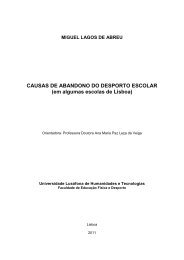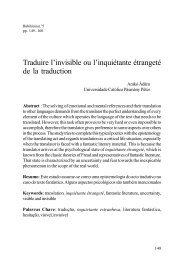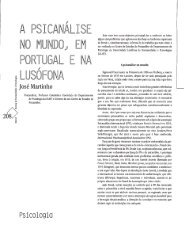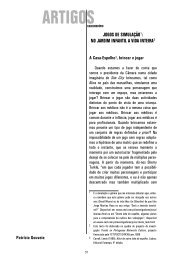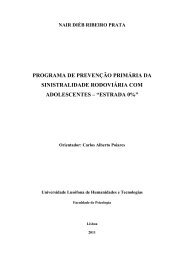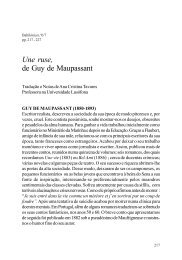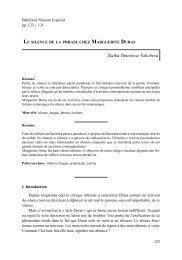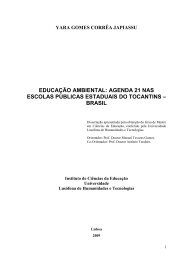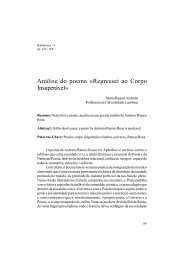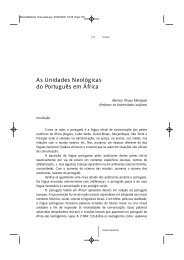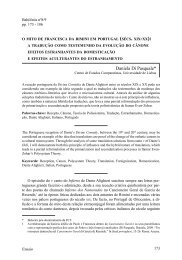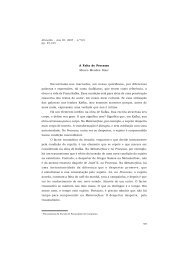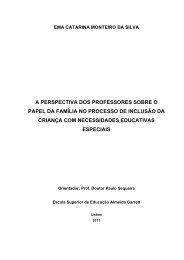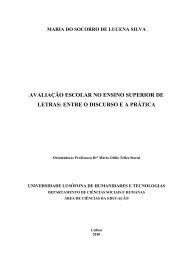Women on March in Goa The Gender Transition in Higher Education ...
Women on March in Goa The Gender Transition in Higher Education ...
Women on March in Goa The Gender Transition in Higher Education ...
You also want an ePaper? Increase the reach of your titles
YUMPU automatically turns print PDFs into web optimized ePapers that Google loves.
<str<strong>on</strong>g>Women</str<strong>on</strong>g> <strong>on</strong> <strong>March</strong> <strong>in</strong> <strong>Goa</strong><br />
<strong>The</strong> <strong>Gender</strong> Transiti<strong>on</strong> <strong>in</strong> <strong>Higher</strong> Educati<strong>on</strong> after<br />
the Statehood<br />
Nandkumar Kamat, Nikita de Silva, Mel<strong>in</strong>da Pereira<br />
<strong>Goa</strong> University, <strong>Goa</strong>, India.<br />
I<br />
Introducti<strong>on</strong><br />
Campus Social, 2006/2007, 3/4, 151-172<br />
This paper attempts to address the <strong>in</strong>terest<strong>in</strong>g phenomen<strong>on</strong> of dom<strong>in</strong>ance of women<br />
<strong>in</strong> higher educati<strong>on</strong>al sector of <strong>Goa</strong>-a remarkable postcol<strong>on</strong>ial event which occurred after<br />
<strong>Goa</strong> atta<strong>in</strong>ed statehood <strong>in</strong> 1987. <strong>The</strong> Indian state of <strong>Goa</strong> has been experienc<strong>in</strong>g a rapid<br />
socio-ec<strong>on</strong>omic and cultural transformati<strong>on</strong>. At present it enjoys many of the highest human<br />
development <strong>in</strong>dicators <strong>in</strong> India, match<strong>in</strong>g some of the developed countries. Its’ projected<br />
populati<strong>on</strong> at present is 1.45 milli<strong>on</strong> (Indian decennial census 2001 reported 1.348 milli<strong>on</strong>).<br />
When the Portuguese rule ended, the literacy was just 31 % whereas it stood at 82 % <strong>in</strong> 2001.<br />
<strong>Goa</strong> is a highly urbanized state <strong>in</strong> India. In 1960 there were just five towns and 15 % urban<br />
populati<strong>on</strong>. In 2001 the figures were, 44 towns and 50 % urban populati<strong>on</strong>. On ec<strong>on</strong>omic<br />
fr<strong>on</strong>t <strong>Goa</strong> has made tremendous progress ma<strong>in</strong>ly <strong>on</strong> account of the growth of m<strong>in</strong><strong>in</strong>g, tourism<br />
and the service sector. Tourist arrivals <strong>in</strong> <strong>Goa</strong> have exceeded the state’s populati<strong>on</strong> from<br />
2001. <strong>The</strong> Gross state domestic product (GSDP) at current prices <strong>in</strong> 2003-04 was Indian<br />
Rupees (Rs.) 96570 milli<strong>on</strong>, up from Rs. 3930 milli<strong>on</strong> when <strong>Goa</strong> became a full-fledged<br />
state. <strong>The</strong> banks are flush with funds <strong>in</strong>dicat<strong>in</strong>g a boom<strong>in</strong>g ec<strong>on</strong>omy. <strong>Goa</strong> has lowest birth<br />
and death rates and a life expectancy of 68 years for the males and 72 for females. <strong>The</strong> sex<br />
ratio however has shown a decl<strong>in</strong><strong>in</strong>g trend s<strong>in</strong>ce 1960, from 1066 to 960 <strong>in</strong> 2001 (Table<br />
1).<strong>The</strong> sex ratio for 0-6 years age group was 933. On this background we <strong>in</strong>tend to exam<strong>in</strong>e<br />
the chang<strong>in</strong>g pattern of female educati<strong>on</strong> <strong>in</strong> <strong>Goa</strong>.
152<br />
Nandkumar Kamat, Nikita de Silva, Mel<strong>in</strong>da Pereira<br />
Table 1 Female sex ratio <strong>in</strong> different talukas of <strong>Goa</strong>- populati<strong>on</strong> census 2001<br />
II<br />
Female literacy<br />
What is the source of new recruitment <strong>in</strong> the higher educati<strong>on</strong>al field?. <strong>The</strong> answer lies<br />
<strong>in</strong> the rapid growth of female literacy s<strong>in</strong>ce 1971 (Table 2) . <strong>The</strong> literacy data of 2001 census<br />
showed that out of 209,766 added to the literate populati<strong>on</strong> dur<strong>in</strong>g 1991-2001 the share of<br />
males and females is almost equal be<strong>in</strong>g 104,972 (50.04 per cent) and 104,794 (49.96 per<br />
cent) respectively. <strong>The</strong> official census report comments – “It is quiet encourag<strong>in</strong>g to note<br />
that females are not beh<strong>in</strong>d <strong>in</strong> the field of literacy <strong>in</strong> the state. It clearly <strong>in</strong>dicates the high<br />
standard of females <strong>in</strong> the socio-cultural field of the <strong>Goa</strong>n Society” . Dom<strong>in</strong>ati<strong>on</strong> of the<br />
females i.e. 22,615 <strong>in</strong> the total decrease of the number of illiterates i.e. 40,397 <strong>in</strong>dicates<br />
the spread of female literacy <strong>in</strong> the state. Almost identical trend was noticed <strong>in</strong> the district<br />
populati<strong>on</strong> also. <strong>The</strong> improvement <strong>in</strong> female literacy rate was higher be<strong>in</strong>g 8.2 percentage<br />
po<strong>in</strong>ts as compared to male literacy ate which is 5.2 percentage po<strong>in</strong>ts.
Table 2: Literacy rates, 1960-2001<br />
Rural-urban literacy rate<br />
<str<strong>on</strong>g>Women</str<strong>on</strong>g> <strong>on</strong> <strong>March</strong> <strong>in</strong> <strong>Goa</strong><br />
As <strong>in</strong>dicated <strong>in</strong> Table 3, there was a gap of 15.5 percentage po<strong>in</strong>ts between the male and<br />
female literacy rates <strong>in</strong> rural <strong>Goa</strong>. Literacy rate am<strong>on</strong>g the urban males was as high as 94.2<br />
per cent. <strong>The</strong> gap between the male and female literacy rate <strong>in</strong> North <strong>Goa</strong> and South <strong>Goa</strong><br />
was almost identical be<strong>in</strong>g 13.3 and 12.6 percentage po<strong>in</strong>ts respectively. <strong>The</strong> corresp<strong>on</strong>d<strong>in</strong>g<br />
figures <strong>in</strong> rural areas were also comparable be<strong>in</strong>g 16.1 percentage po<strong>in</strong>ts <strong>in</strong> North <strong>Goa</strong> as<br />
aga<strong>in</strong>st 14.2 percentage po<strong>in</strong>ts <strong>in</strong> South <strong>Goa</strong>. <strong>The</strong> gap between male and female literacy rates<br />
<strong>in</strong> urban areas of North <strong>Goa</strong> worked out 9.9 percentage po<strong>in</strong>ts as aga<strong>in</strong>st 11.1 percentage<br />
po<strong>in</strong>ts <strong>in</strong> South <strong>Goa</strong> District.<br />
Table 3: Literacy rates <strong>in</strong> different talukas of <strong>Goa</strong>- populati<strong>on</strong> census 2001 (per cent)<br />
153
154<br />
Nandkumar Kamat, Nikita de Silva, Mel<strong>in</strong>da Pereira<br />
III<br />
Educati<strong>on</strong>al facilities for women<br />
<strong>The</strong>re are several factors which have given rise to a gradual upsurge of <strong>in</strong>terest am<strong>on</strong>g<br />
the women <strong>in</strong> <strong>Goa</strong> for higher educati<strong>on</strong>. We need to compare the present picture with the<br />
scenario dur<strong>in</strong>g the Portuguese col<strong>on</strong>ial rule.<br />
<strong>The</strong> col<strong>on</strong>ial period<br />
Sr. Emma Maria, A. C. <strong>in</strong> her <str<strong>on</strong>g>Women</str<strong>on</strong>g> <strong>in</strong> Portuguese <strong>Goa</strong>, 1510-1835 (2002) presents<br />
a c<strong>on</strong>cise chr<strong>on</strong>ological picture of status of educati<strong>on</strong>al facilities for women under the<br />
Portuguese rule. “Girls were not sent to schools, but were generally <strong>in</strong>structed at home.<br />
Later <strong>in</strong> 1606 they were educated at the Royal C<strong>on</strong>vent of Santa M<strong>on</strong>ica and <strong>in</strong> the Homes<br />
of Nossa Senhora de Serra and that of Santa Maria Magdalena.’ But the situati<strong>on</strong> seems to<br />
have improved <strong>in</strong> the 19th century. Sr. Emma menti<strong>on</strong>s that –“ New educati<strong>on</strong>al policies<br />
were approved <strong>in</strong> Portugal and they were extended to <strong>Goa</strong>. In 1846, a school for girls was<br />
opened at Panjim. In 1854 two more such schools were opened, <strong>on</strong>e at Mapusa and another<br />
at Margao. In 1882, there was a move to start three special schools for girls <strong>in</strong> the three<br />
ma<strong>in</strong> c<strong>on</strong>celhos of <strong>Goa</strong>, namely Ilhas, Bardez and Salcete. <strong>The</strong> first step was taken by the<br />
Prov<strong>in</strong>cial Board. Junta Geral de Prov<strong>in</strong>cia. <strong>The</strong> plan that was approved by the Government<br />
could not be implemented due to lack of funds. However, <strong>in</strong> the year 1887, at the <strong>in</strong>itiative<br />
of Santa Casa de Misericordia de <strong>Goa</strong>, sisters of the Franciscan Hospitallers opened a school<br />
for girls, the school of Our Lady of Piety, A Escola de Nossa Senhora de Piedade, <strong>in</strong> the<br />
c<strong>on</strong>vent of Chimbel which was later transferred to Panjim. <strong>The</strong> subjects taught <strong>in</strong> the school<br />
were Portuguese, English and French, besides needlework, embroidery, cookery and other<br />
allied “housewifery” subjects. <strong>The</strong> <strong>in</strong>stituti<strong>on</strong> was recognised by the Government and had<br />
to follow rules and regulati<strong>on</strong>s approved by the Government. In 1892, the local Government<br />
by an order dated 31 December, planned for the establishment of eight primary schools for<br />
girls <strong>in</strong>clud<strong>in</strong>g special texts for them <strong>in</strong> all fields of educati<strong>on</strong>.”<br />
A significant development was the end of m<strong>on</strong>archy <strong>in</strong> Portugal. <strong>The</strong> republican<br />
adm<strong>in</strong>istrati<strong>on</strong> adopted a liberal educati<strong>on</strong>al policy. By a government decree of 4 January<br />
1911, a school for girls was established, the Nati<strong>on</strong>al School for the Female Sex, (Escola<br />
Naci<strong>on</strong>al de Sexo Fem<strong>in</strong><strong>in</strong>o) a secular <strong>in</strong>stituti<strong>on</strong> <strong>in</strong> place of the college of Our Lady of Piety<br />
(Colegio da Nossa Senhora de Piedade) a c<strong>on</strong>gregati<strong>on</strong>al <strong>in</strong>stituti<strong>on</strong>. A special school for<br />
girls’ educati<strong>on</strong>, the open<strong>in</strong>g of the Normal School of teachers’ tra<strong>in</strong><strong>in</strong>g to all communities<br />
creati<strong>on</strong> of the New Lyceum, expansi<strong>on</strong> of the already established Medical and Pharmacy<br />
courses and creati<strong>on</strong> of the Commercial Institute for Professi<strong>on</strong>al Educati<strong>on</strong> were some of<br />
the salient features of reorganisati<strong>on</strong> of the educati<strong>on</strong>al plan of the republican government.<br />
In 1920, a women’s Institute of Educati<strong>on</strong> (lnstituto Fem<strong>in</strong><strong>in</strong>o de Educacao) was established<br />
which provided courses <strong>in</strong> Domestic Science and music. <strong>The</strong> four -year sec<strong>on</strong>dary course<br />
comprised of the follow<strong>in</strong>g subjects: Portuguese, French, English, Geography, History,
<str<strong>on</strong>g>Women</str<strong>on</strong>g> <strong>on</strong> <strong>March</strong> <strong>in</strong> <strong>Goa</strong><br />
Mathematics, Physics and Chemistry, Natural Science, Draw<strong>in</strong>g and Model<strong>in</strong>g, Educati<strong>on</strong>al<br />
handicraft, drill and games “suited to the fair sex,” music and s<strong>in</strong>g<strong>in</strong>g. <strong>The</strong> three-year<br />
special course comprised of Portuguese, Literature, French, English, cutt<strong>in</strong>g and tailor<strong>in</strong>g,<br />
embroidery, domestic ec<strong>on</strong>omy, cookery, garden<strong>in</strong>g, horticulture, rear<strong>in</strong>g of domestic animals,<br />
drill music and pa<strong>in</strong>t<strong>in</strong>g. <strong>The</strong> period of Portuguese republican rule (1910-1926) was the<br />
<strong>on</strong>ly ray of hope for <strong>Goa</strong>n women. <strong>The</strong> “C<strong>on</strong>gress Prov<strong>in</strong>cial” discussed the progress of<br />
<strong>Goa</strong>n women <strong>in</strong> a special sessi<strong>on</strong> <strong>in</strong> 1931. Leaders of <strong>Goa</strong>’s H<strong>in</strong>du community –Shambarao<br />
Sardessai and Dr. Atmaram Borkar champi<strong>on</strong>ed the cause of appropriate educati<strong>on</strong> for H<strong>in</strong>du<br />
women. <strong>The</strong>ir views were supported by the teacher – D<strong>on</strong>a Propercia Correia Af<strong>on</strong>so. In<br />
1933, the Saraswat Brahm<strong>in</strong> Samaj of Margao organized a bra<strong>in</strong> storm<strong>in</strong>g sessi<strong>on</strong> for three<br />
days to discuss the issue of womens’ educati<strong>on</strong>. This was followed by the open<strong>in</strong>g of the<br />
three schools for girls. Slowly the girls came forward to enroll. Between 1935 to 1952,<br />
the figures <strong>in</strong>dicate that 292 girls had completed primary school certificate exam<strong>in</strong>ati<strong>on</strong> as<br />
compared to 105 boys. <strong>The</strong> <strong>in</strong>stituti<strong>on</strong> which was started <strong>in</strong> place of the Colegio da Nossa<br />
Senhora de Piedade <strong>in</strong> 1911 at the beg<strong>in</strong>n<strong>in</strong>g of the republican regime, and s<strong>in</strong>ce c<strong>on</strong>t<strong>in</strong>ued<br />
as a secular <strong>in</strong>stituti<strong>on</strong> was closed <strong>on</strong> 15 May 1952. <strong>The</strong> government decree No. 7361, dated<br />
31 October 1958, made primary educati<strong>on</strong> compulsory for children of both sexes, <strong>in</strong> the age<br />
group of seven and thirteen.<br />
<strong>The</strong> post-col<strong>on</strong>ial period<br />
<strong>Goa</strong> had limited opportunities for women <strong>in</strong> higher educati<strong>on</strong> under the Portuguese<br />
col<strong>on</strong>ial rule. But this picture has changed radically at present. After <strong>in</strong>tegrati<strong>on</strong> with the<br />
Indian uni<strong>on</strong>, <strong>Goa</strong> was adm<strong>in</strong>istered as an Uni<strong>on</strong> territory till the grant<strong>in</strong>g of full-fledged<br />
statehood <strong>on</strong> 30 May 1987. Dur<strong>in</strong>g the pre-statehood period (1962-1987) there was much<br />
emphasis <strong>on</strong> primary, middle and high school educati<strong>on</strong>. <strong>Goa</strong> follows the Nati<strong>on</strong>al Policy<br />
<strong>on</strong> educati<strong>on</strong> 1986, modified <strong>in</strong> 1992. <strong>The</strong> 10+2+3 pattern of educati<strong>on</strong> is implemented.<br />
<strong>The</strong> students spend 10 years <strong>in</strong> schools. After clear<strong>in</strong>g the Sec<strong>on</strong>dary School certificate<br />
exam<strong>in</strong>ati<strong>on</strong> (SSCE) of the <strong>Goa</strong> Board of Sec<strong>on</strong>dary and <strong>Higher</strong> Sec<strong>on</strong>dary educati<strong>on</strong><br />
(GBSHSE) (www. goaeduboard.org), they can choose <strong>on</strong>e of the four streams, i.e. Arts,<br />
Commerce, Science or Vocati<strong>on</strong>al <strong>in</strong> the <strong>Higher</strong> Sec<strong>on</strong>dary Schools (HSS) or post SSCE<br />
technical courses. This is the +2 stage-the beg<strong>in</strong>n<strong>in</strong>g of higher educati<strong>on</strong>. After answer<strong>in</strong>g<br />
<strong>Higher</strong> Sec<strong>on</strong>dary School certificate exam<strong>in</strong>ati<strong>on</strong> (HSSCE) of GBHSE, the students can opt<br />
for graduati<strong>on</strong> <strong>in</strong> general or professi<strong>on</strong>al colleges. This is the +3 stage of higher educati<strong>on</strong>.<br />
<strong>The</strong>re are two central agencies which c<strong>on</strong>trol graduate level educati<strong>on</strong>-the University Grants<br />
Commissi<strong>on</strong> (UGC) (www.ugc.ac.<strong>in</strong>) and the All India Council for technical Educati<strong>on</strong><br />
(AICTE) (www.aicte.ernet.<strong>in</strong>). <strong>The</strong> <strong>Goa</strong> University (goauniversity.org) is a public university<br />
established <strong>in</strong> 1985 by an act of <strong>Goa</strong> state legislative assembly. All the colleges <strong>in</strong> the state<br />
are affiliated to it. <strong>Goa</strong> University offers Post graduate courses of two-three years durati<strong>on</strong><br />
with a fixed <strong>in</strong>take capacity of students.<br />
155
156<br />
Nandkumar Kamat, Nikita de Silva, Mel<strong>in</strong>da Pereira<br />
<strong>The</strong> post-Statehood period<br />
A very simple, work<strong>in</strong>g divisi<strong>on</strong> of <strong>Goa</strong>’s postcol<strong>on</strong>ial period can be given as follows:<br />
1. Period of Uni<strong>on</strong> territory adm<strong>in</strong>istrati<strong>on</strong> of <strong>Goa</strong>, Daman and Diu, the former Portuguese<br />
ruled territories from 19th December 1961 to 29th May 1987.<br />
2. <strong>The</strong> statehood period from 30th May 1987 till date.<br />
<strong>The</strong> political history of <strong>Goa</strong> has <strong>in</strong>fluenced its ec<strong>on</strong>omic history to a large extent.<br />
Socio-ec<strong>on</strong>omic <strong>in</strong>dicators clearly show the statehood period also resulted <strong>in</strong> a phenomenal<br />
growth <strong>in</strong> <strong>Goa</strong>’s ec<strong>on</strong>omy. <strong>The</strong> GSDP multiplied by 25 times. <strong>The</strong> per capita <strong>in</strong>come rose<br />
substantially. Another <strong>in</strong>dicator is the rapid urbanizati<strong>on</strong> of <strong>Goa</strong> dur<strong>in</strong>g this period. We<br />
have selected the statehood period also from the c<strong>on</strong>text of the sweep<strong>in</strong>g changes <strong>in</strong> India’s<br />
ec<strong>on</strong>omic trade and <strong>in</strong>vestment policies and the beg<strong>in</strong>n<strong>in</strong>g of liberalizati<strong>on</strong> of the ec<strong>on</strong>omy,<br />
growth of c<strong>on</strong>sumer market and the meteoric rise of the Indian middle class.<br />
IV<br />
Data sets-the official educati<strong>on</strong>al statistics<br />
We have c<strong>on</strong>sidered a data series of 18 years (here<strong>in</strong>after referred as ‘study period’)<br />
with<strong>in</strong> which data for specific years was selected for a comparative chr<strong>on</strong>ological analysis<br />
of five temporal blocks. 1987-1988 was selected s<strong>in</strong>ce it was the first year after <strong>Goa</strong> atta<strong>in</strong>ed<br />
statehood status, 1992-1993 was selected as the beg<strong>in</strong>n<strong>in</strong>g of the eighth five-year plan of<br />
the state, 1996-1997 was selected as the f<strong>in</strong>al year of the eighth five-year plan of the state,<br />
1999-2000 was selected as a mid po<strong>in</strong>t of the n<strong>in</strong>th five-year plan and also as the last year<br />
of the previous century and 2004-2005 was selected, as the latest data was available <strong>on</strong>ly<br />
for that year. So <strong>in</strong> all five statistical data sets have been used for comparative analysis.<br />
Major sources of data<br />
<strong>The</strong> directorate of educati<strong>on</strong> of <strong>Goa</strong> has a statistics secti<strong>on</strong> which compiles enrollment<br />
figures of the students at all levels of educati<strong>on</strong>, besides ma<strong>in</strong>ta<strong>in</strong>s statistics about educati<strong>on</strong>al<br />
<strong>in</strong>stituti<strong>on</strong>s, teachers, schedule castes (SC), schedule tribes (ST), school drop out rates, gender<br />
ratio and rural urban distributi<strong>on</strong>. <strong>The</strong> annual reports are titled ‘Educati<strong>on</strong>al statistics at a<br />
glance’ and are published regularly <strong>in</strong> September every year. <strong>The</strong> data series goes back to<br />
1964-1965. This is the primary source of <strong>in</strong>formati<strong>on</strong>. From government of India census office<br />
decadal census reports are available. <strong>The</strong> latest <strong>on</strong>e perta<strong>in</strong>s to 2001. From this demographic<br />
<strong>in</strong>formati<strong>on</strong> and literacy rates can be obta<strong>in</strong>ed. S<strong>in</strong>ce 1999-2000, the Government of <strong>Goa</strong><br />
also publishes ec<strong>on</strong>omic surveys (ES), which c<strong>on</strong>ta<strong>in</strong> important developmental <strong>in</strong>formati<strong>on</strong><br />
al<strong>on</strong>g with statistical tables. We have c<strong>on</strong>sidered ec<strong>on</strong>omic surveys from 2001-02 to 2005-06.<br />
<strong>The</strong> <strong>Goa</strong> University publishes an annual report every year giv<strong>in</strong>g the enrollment statistics<br />
<strong>in</strong> all its’ affiliated colleges and the post graduate faculties.
V<br />
Major objectives<br />
<str<strong>on</strong>g>Women</str<strong>on</strong>g> <strong>on</strong> <strong>March</strong> <strong>in</strong> <strong>Goa</strong><br />
<strong>The</strong> questi<strong>on</strong>s which <strong>in</strong>terested us were<br />
1.Whether expansi<strong>on</strong> of higher educati<strong>on</strong>al facilities have created better opportunities<br />
for the women to get admissi<strong>on</strong>?<br />
2.Whether the gender ratio has been show<strong>in</strong>g a positive change over the study period?<br />
3.Whether the educati<strong>on</strong>al preference is shift<strong>in</strong>g at different levels of higher educati<strong>on</strong><br />
and to what extent?<br />
4.Whether gender ratios <strong>in</strong> different streams reflect any particular trend which could be<br />
related to the market forces?<br />
5.Whether at the post graduati<strong>on</strong> level gender ratios have ma<strong>in</strong>ta<strong>in</strong>ed a c<strong>on</strong>sistently<br />
positive profile over the study period?<br />
6.Whether any trends <strong>in</strong>dicat<strong>in</strong>g a better deal for women <strong>in</strong> higher educati<strong>on</strong> can be<br />
identified?<br />
Data analysis<br />
For the purpose of analysis, data tables were compiled for three levels of higher educati<strong>on</strong><br />
a) the +2 level known <strong>in</strong> <strong>Goa</strong> as <strong>Higher</strong> Sec<strong>on</strong>dary School (HSS) Level, b) <strong>The</strong> graduati<strong>on</strong>/<br />
college level or the +3 Level and c) Post graduati<strong>on</strong> level at the <strong>Goa</strong> University. Data from<br />
other post Matric courses and professi<strong>on</strong>al graduate courses has not been <strong>in</strong>cluded ow<strong>in</strong>g<br />
to identified gaps <strong>in</strong> the time series.<br />
After matriculati<strong>on</strong> or +10 stage there are three opti<strong>on</strong>s:-<br />
1.Students can jo<strong>in</strong> a general stream of HSS unit<br />
2.Choose a vocati<strong>on</strong>al course offered by the HSS unit or<br />
3.Jo<strong>in</strong> <strong>in</strong>stituti<strong>on</strong>s for professi<strong>on</strong>al or technical educati<strong>on</strong> which are not affiliated to<br />
the HSS board. <strong>The</strong>se <strong>in</strong>clude ma<strong>in</strong>ly ITIs (<strong>in</strong>dustrial Tra<strong>in</strong><strong>in</strong>g Institutes) and Polytechnics<br />
affiliated to All India Council For Technical Educati<strong>on</strong> (AICTE).<br />
At +2 level the three c<strong>on</strong>venti<strong>on</strong>al streams are Arts, Commerce and Science. After<br />
Government of India’s new policy <strong>in</strong> 1986, Vocati<strong>on</strong>alizati<strong>on</strong> at +2 stage was <strong>in</strong>troduced <strong>in</strong><br />
1988-1999. At graduati<strong>on</strong> level there are two major divisi<strong>on</strong>s<br />
a) Instituti<strong>on</strong>s which offer general educati<strong>on</strong> such as Arts, Commerce and Science and<br />
b) Instituti<strong>on</strong>s which offer professi<strong>on</strong>al courses such as pharmacy, medic<strong>in</strong>e, dentistry,<br />
eng<strong>in</strong>eer<strong>in</strong>g, home science, architecture, f<strong>in</strong>e arts and law. Depend<strong>in</strong>g <strong>on</strong> the type of degrees<br />
the graduati<strong>on</strong> period is m<strong>in</strong>imum three academic years and maximum 5 academic years.<br />
At post graduati<strong>on</strong> (PG) level there are four streams which are affiliated to the <strong>on</strong>ly<br />
University <strong>in</strong> the state, i.e. <strong>Goa</strong> University. Depend<strong>in</strong>g <strong>on</strong> the PG degree, the period of post<br />
graduati<strong>on</strong> may differ from a m<strong>in</strong>imum of 2 years to a maximum of 3 years. <strong>Higher</strong> degrees<br />
like M. Phil. and Ph.D. are also offered. <strong>The</strong> time series data is broadly classified <strong>on</strong> the basis<br />
157
158<br />
Nandkumar Kamat, Nikita de Silva, Mel<strong>in</strong>da Pereira<br />
of selected years and the above menti<strong>on</strong>ed levels of higher educati<strong>on</strong>. Enrollment figures for<br />
males and females for these years have been given <strong>in</strong> the table nos. 4 –18. <strong>The</strong> gender ratio<br />
is expressed as percentages of females to the total enrollment. On basis of this an attempt<br />
has been made to answer the questi<strong>on</strong>s menti<strong>on</strong>ed previously.<br />
VI<br />
Better opportunities <strong>in</strong> higher educati<strong>on</strong><br />
<strong>The</strong> data clearly shows that the higher educati<strong>on</strong>al facilities were well distributed after<br />
the growth of HSS units and colleges <strong>in</strong> rural areas of <strong>Goa</strong> thus enabl<strong>in</strong>g the women to get<br />
admissi<strong>on</strong>s easily and sav<strong>in</strong>g the time <strong>on</strong> travel<strong>in</strong>g to urban centers.<br />
Growth of <strong>Higher</strong> Sec<strong>on</strong>dary Schools<br />
In 1987-1988 there were 23 HSS units. <strong>The</strong>ir number rose remarkably to 49 <strong>in</strong> 1992-1993<br />
at almost the end of the 8th five-year plan. <strong>The</strong>re was a rapid growth of HSS units and the<br />
number reached 81 <strong>in</strong> 1996-7. This number has not changed s<strong>in</strong>ce then. It is <strong>in</strong>terest<strong>in</strong>g to note<br />
that many of these higher sec<strong>on</strong>dary units have been established <strong>in</strong> rural areas. As compared<br />
to 12 HSS units <strong>in</strong> 1987-1988 (50%) <strong>in</strong> urban areas, <strong>in</strong> 2004-2005, the ratio favoured the<br />
rural areas with 47 (56%) HSS units <strong>in</strong> rural areas out of 81 <strong>in</strong>dicat<strong>in</strong>g a dramatic social<br />
transiti<strong>on</strong> dur<strong>in</strong>g the study period.<br />
One of the reas<strong>on</strong>s could be the spurt <strong>in</strong> female literacy experienced between 1971-1991.<br />
As compared to 36% female literacy <strong>in</strong> 1971, <strong>Goa</strong> had 67% literate females <strong>in</strong> 1991 <strong>in</strong>dicat<strong>in</strong>g<br />
almost a 200% jump <strong>in</strong> two decades. Naturally the pre high school literate populati<strong>on</strong> availed<br />
the higher sec<strong>on</strong>dary facilities which were expand<strong>in</strong>g <strong>in</strong> their neighborhood.<br />
Growth of colleges<br />
In 1987-1988 there were 12 <strong>in</strong>stituti<strong>on</strong>s impart<strong>in</strong>g general educati<strong>on</strong> and 12 professi<strong>on</strong>al<br />
educati<strong>on</strong> at graduati<strong>on</strong> level. This number <strong>in</strong>creased to 14 for general and 21 for professi<strong>on</strong>al<br />
educati<strong>on</strong> <strong>in</strong> 2004-05. A significant aspect was the open<strong>in</strong>g of new government colleges<br />
for general educati<strong>on</strong> at Pernem, Sanquelim, Khandhola and Quepem thus br<strong>in</strong>g<strong>in</strong>g college<br />
educati<strong>on</strong> closer to the rural areas. A college of home science was also established specifically<br />
cater<strong>in</strong>g to the women <strong>in</strong> 1988-1989.<br />
Better facilities for post graduate educati<strong>on</strong><br />
<strong>The</strong> <strong>Goa</strong> University came <strong>in</strong>to existence <strong>on</strong> 30th June 1985. Earlier there was a Center<br />
of Post Graduati<strong>on</strong> Instructi<strong>on</strong>s and Research (CPIR) established under the university of<br />
Bombay s<strong>in</strong>ce June 1965. <strong>The</strong> first batch of students under <strong>Goa</strong> University were admitted<br />
<strong>in</strong> 1987-1988. <strong>The</strong> <strong>Goa</strong> University shifted to its own campus <strong>in</strong> 1991-1992. With the
<str<strong>on</strong>g>Women</str<strong>on</strong>g> <strong>on</strong> <strong>March</strong> <strong>in</strong> <strong>Goa</strong><br />
establishment of hostel facilities for the lady students the post graduati<strong>on</strong> departments<br />
experienced excellent growth s<strong>in</strong>ce 1990-1993. Till BITS (Birla Institute of Technology and<br />
Science) Pilani established its’ <strong>Goa</strong> campus at Zuar<strong>in</strong>agar <strong>in</strong> Marmagoa <strong>in</strong> 2005-2006, there<br />
was no other <strong>in</strong>dependent <strong>in</strong>stituti<strong>on</strong> of post graduati<strong>on</strong> educati<strong>on</strong> except <strong>Goa</strong> University.<br />
BITS Pilani is a deemed university.<br />
VII<br />
<strong>The</strong> gender revoluti<strong>on</strong> <strong>in</strong> higher educati<strong>on</strong><br />
We noticed a def<strong>in</strong>ite positive change <strong>in</strong> the enrollment of the women from higher<br />
sec<strong>on</strong>dary school level dur<strong>in</strong>g the study period.<br />
<strong>The</strong> chang<strong>in</strong>g gender ratio at <strong>Higher</strong> Sec<strong>on</strong>dary level<br />
Female enrollment trends <strong>in</strong> the general streams (Arts, Commerce, Science) and<br />
Vocati<strong>on</strong>al stream offer c<strong>on</strong>trast<strong>in</strong>g pictures. <strong>The</strong> time series data is summarized <strong>in</strong> Tables<br />
4-8 and the trends are plotted graphically as shown <strong>in</strong> Chart 1-a-e.<br />
159
160<br />
Nandkumar Kamat, Nikita de Silva, Mel<strong>in</strong>da Pereira<br />
General streams<br />
In the year 1987-1988, at HSS level the gender ratio was tilted <strong>in</strong> favour of the males<br />
(54.20%) for general streams <strong>in</strong> 1992-1993. In the year 1992-1993, the female enrollment<br />
marg<strong>in</strong>ally went up from 45.8% to 46.93% <strong>in</strong> general streams. Turn<strong>in</strong>g po<strong>in</strong>t <strong>in</strong> gender ratio<br />
reached <strong>in</strong> 1996-1997 with 49.7% female enrollment. <strong>Gender</strong> transiti<strong>on</strong> was clearly visible<br />
<strong>in</strong> HSS educati<strong>on</strong> <strong>in</strong> 1999-2000 at 51.7%. This ratio has been s<strong>in</strong>ce ma<strong>in</strong>ta<strong>in</strong>ed at 51.77%<br />
overall dur<strong>in</strong>g the study period. <strong>The</strong> female enrollment <strong>in</strong> general streams of HSS units<br />
<strong>in</strong>creased by 6% after statehood thus end<strong>in</strong>g the phase of gender imbalance at HSS level.<br />
Vocati<strong>on</strong>al stream<br />
Vocati<strong>on</strong>alizati<strong>on</strong> of HSS educati<strong>on</strong> began <strong>in</strong> 1988-1989 with full f<strong>in</strong>ancial support from<br />
the central government. In 1992-1993, there were <strong>on</strong>ly 38.6% females <strong>in</strong> vocati<strong>on</strong>al stream.<br />
This percentage went up phenomenally <strong>in</strong> 1996-1997 and reached 57.53%. One reas<strong>on</strong> was<br />
a large number of <strong>in</strong>stitutes which began offer<strong>in</strong>g a wide choice of vocati<strong>on</strong>al educati<strong>on</strong><br />
courses. In 1999-2000 <strong>in</strong>terest<strong>in</strong>gly, the female enrollment decreased to 43.90% and at<br />
present it stands at 39.09% almost reach<strong>in</strong>g the same level of 1992-1993.<br />
One reas<strong>on</strong> could be that as projected earlier by the government vocati<strong>on</strong>alizati<strong>on</strong> did<br />
not result <strong>in</strong>to immediate employment. This caused disillusi<strong>on</strong>ment am<strong>on</strong>g females over<br />
last 10 years. <strong>The</strong> drop <strong>in</strong> female enrollment for vocati<strong>on</strong>al stream is matched by the rise <strong>in</strong><br />
female enrollment <strong>in</strong> Arts stream of HSS units.<br />
Educati<strong>on</strong>al statistics for 1987-1988<br />
<strong>Higher</strong> sec<strong>on</strong>dary level<br />
Number of higher sec<strong>on</strong>daries: 23<br />
Number of <strong>in</strong>stituti<strong>on</strong>s offer<strong>in</strong>g vocati<strong>on</strong>al educati<strong>on</strong>: 0<br />
Table: 4 Enrollment for HSS courses<br />
Educati<strong>on</strong>al statistics for 1992-1993<br />
<strong>Higher</strong> sec<strong>on</strong>dary level<br />
Number of higher sec<strong>on</strong>daries: 49<br />
Number of <strong>in</strong>stituti<strong>on</strong>s offer<strong>in</strong>g vocati<strong>on</strong>al educati<strong>on</strong>: 25
Table 5: Enrollment for HSS courses<br />
Educati<strong>on</strong>al statistics for 1996-1997<br />
<strong>Higher</strong> sec<strong>on</strong>dary level<br />
Number of higher sec<strong>on</strong>daries: 81<br />
Number of <strong>in</strong>stituti<strong>on</strong>s offer<strong>in</strong>g vocati<strong>on</strong>al educati<strong>on</strong>: 12<br />
Table 6: Enrollment for HSS courses<br />
Educati<strong>on</strong>al statistics for 1999-2000<br />
<strong>Higher</strong> sec<strong>on</strong>dary level<br />
Number of higher sec<strong>on</strong>daries: 81<br />
Number of <strong>in</strong>stituti<strong>on</strong>s offer<strong>in</strong>g vocati<strong>on</strong>al educati<strong>on</strong>: 12<br />
<str<strong>on</strong>g>Women</str<strong>on</strong>g> <strong>on</strong> <strong>March</strong> <strong>in</strong> <strong>Goa</strong><br />
161
162<br />
Nandkumar Kamat, Nikita de Silva, Mel<strong>in</strong>da Pereira<br />
Table 7: Enrollment for HSS courses<br />
Educati<strong>on</strong>al statistics for 2004-2005<br />
<strong>Higher</strong> sec<strong>on</strong>dary level<br />
Number of higher sec<strong>on</strong>daries: 81<br />
Number of <strong>in</strong>stituti<strong>on</strong>s offer<strong>in</strong>g vocati<strong>on</strong>al educati<strong>on</strong>: 40<br />
Table 8: Enrollment for HSS courses<br />
<strong>Gender</strong> ratio at graduati<strong>on</strong> level<br />
<strong>The</strong> time series data is summarized <strong>in</strong> Tables 9-13 and the trends are depicted graphically<br />
<strong>in</strong> Chart 2, a-e. This gender transiti<strong>on</strong> began <strong>in</strong> the pre statehood days <strong>in</strong> 1987-1988. After<br />
<strong>Goa</strong> got statehood, <strong>in</strong> 1987-88, we f<strong>in</strong>d a female enrollment ratio of 51.91% <strong>in</strong> the general<br />
streams of graduati<strong>on</strong>. This <strong>in</strong>creased to 53.33% <strong>in</strong> 1992-1993, 58.83% <strong>in</strong> 1996-1997 and<br />
62.85% <strong>in</strong> 1999-2000 before marg<strong>in</strong>ally reduc<strong>in</strong>g to 61.25%. Dur<strong>in</strong>g the study period we<br />
detected a remarkable overall growth <strong>in</strong> the gender ratio favour<strong>in</strong>g the females over the males<br />
by almost 10% po<strong>in</strong>ts. <strong>The</strong> college campuses have now come to be dom<strong>in</strong>ated by females<br />
<strong>in</strong>dicat<strong>in</strong>g an important social transiti<strong>on</strong> <strong>in</strong> post col<strong>on</strong>ial <strong>Goa</strong>n Society.
Educati<strong>on</strong>al statistics for 1987-1988<br />
Graduati<strong>on</strong> level<br />
Number of <strong>in</strong>stituti<strong>on</strong>s offer<strong>in</strong>g general educati<strong>on</strong>: 12<br />
Number of <strong>in</strong>stituti<strong>on</strong>s offer<strong>in</strong>g professi<strong>on</strong>al educati<strong>on</strong>: 12<br />
<str<strong>on</strong>g>Women</str<strong>on</strong>g> <strong>on</strong> <strong>March</strong> <strong>in</strong> <strong>Goa</strong><br />
163
164<br />
Nandkumar Kamat, Nikita de Silva, Mel<strong>in</strong>da Pereira<br />
Table 9: Enrollment at Graduati<strong>on</strong> level (General streams)<br />
Educati<strong>on</strong>al statistics for 1992-1993<br />
Graduati<strong>on</strong> level<br />
Number of <strong>in</strong>stituti<strong>on</strong>s offer<strong>in</strong>g general educati<strong>on</strong>: 12<br />
Number of <strong>in</strong>stituti<strong>on</strong>s offer<strong>in</strong>g professi<strong>on</strong>al educati<strong>on</strong>: 12<br />
Table 10: Enrollment at Graduati<strong>on</strong> level (General streams)<br />
Educati<strong>on</strong>al statistics for 1996-1997<br />
Graduati<strong>on</strong> level<br />
Number of <strong>in</strong>stituti<strong>on</strong>s offer<strong>in</strong>g general educati<strong>on</strong>: 12<br />
Number of <strong>in</strong>stituti<strong>on</strong>s offer<strong>in</strong>g Professi<strong>on</strong>al educati<strong>on</strong>: 17
Table 11: Enrollment at Graduati<strong>on</strong> level (General streams)<br />
Educati<strong>on</strong>al statistics for 1999-2000<br />
Graduati<strong>on</strong> level<br />
Number of <strong>in</strong>stituti<strong>on</strong>s offer<strong>in</strong>g general educati<strong>on</strong>: 14<br />
Number of <strong>in</strong>stituti<strong>on</strong>s offer<strong>in</strong>g professi<strong>on</strong>al educati<strong>on</strong>: 20<br />
Table 12: Enrollment at Graduati<strong>on</strong> level (General streams)<br />
Educati<strong>on</strong>al statistics for 2004-2005<br />
Graduati<strong>on</strong> level<br />
Number of <strong>in</strong>stituti<strong>on</strong>s offer<strong>in</strong>g general educati<strong>on</strong>: 14<br />
Number of <strong>in</strong>stituti<strong>on</strong>s offer<strong>in</strong>g professi<strong>on</strong>al educati<strong>on</strong>: 21<br />
<str<strong>on</strong>g>Women</str<strong>on</strong>g> <strong>on</strong> <strong>March</strong> <strong>in</strong> <strong>Goa</strong><br />
165
166<br />
Nandkumar Kamat, Nikita de Silva, Mel<strong>in</strong>da Pereira<br />
Table 13: Enrollment at Graduati<strong>on</strong> level (General streams)<br />
<strong>Gender</strong> transiti<strong>on</strong> at post graduati<strong>on</strong> level<br />
<strong>The</strong> female gender ratio at post graduati<strong>on</strong> level has more or less followed the same<br />
growth trend at the graduate level (refer to Tables 14-18 and Chart 3, a-e). In 1987-1988 it<br />
was 48.07% which <strong>in</strong>creased to 49.3% <strong>in</strong> 1992-1993 and reached its’ peak <strong>in</strong> 1996-1997<br />
at 66.12%, before fall<strong>in</strong>g to 63.29% <strong>in</strong> 1999-2000 and further to 62.9% <strong>in</strong> 2004-2005. <strong>The</strong><br />
fall from the peak ratio <strong>in</strong> 1996-1997 is attributed to the fixed number of seats <strong>in</strong> all the<br />
departments <strong>in</strong> <strong>Goa</strong> University and the change <strong>in</strong> admissi<strong>on</strong> policy by c<strong>on</strong>duct<strong>in</strong>g written<br />
tests. However the high female gender ratio is be<strong>in</strong>g ma<strong>in</strong>ta<strong>in</strong>ed <strong>in</strong> <strong>Goa</strong> University <strong>on</strong> account<br />
of the predom<strong>in</strong>ance of female students <strong>in</strong> the arts and science faculties.
Educati<strong>on</strong>al statistics for 1987-88<br />
Post graduati<strong>on</strong> level<br />
Table 14: Enrollment <strong>in</strong> general streams<br />
Educati<strong>on</strong>al statistics for 1992-93<br />
Post graduati<strong>on</strong> level<br />
<str<strong>on</strong>g>Women</str<strong>on</strong>g> <strong>on</strong> <strong>March</strong> <strong>in</strong> <strong>Goa</strong><br />
167
168<br />
Nandkumar Kamat, Nikita de Silva, Mel<strong>in</strong>da Pereira<br />
Table 15: Enrollment <strong>in</strong> general streams<br />
Educati<strong>on</strong>al statistics for 1996-1997<br />
Post graduati<strong>on</strong> level<br />
Table 16: Enrollment <strong>in</strong> general streams<br />
Educati<strong>on</strong>al statistics for 1999-2000<br />
Post graduati<strong>on</strong> level
Table 17: Enrollment <strong>in</strong> general streams<br />
Educati<strong>on</strong>al statistics for 2004-05<br />
Post graduati<strong>on</strong> level<br />
Table 18: Enrollment <strong>in</strong> general streams<br />
VIII<br />
A clear and dist<strong>in</strong>ctly positive trend<br />
<str<strong>on</strong>g>Women</str<strong>on</strong>g> <strong>on</strong> <strong>March</strong> <strong>in</strong> <strong>Goa</strong><br />
For the study period, <strong>on</strong> the basis of statistical analysis for general streams we can see<br />
a significant <strong>in</strong>crease <strong>in</strong> female enrollment at all the three levels of higher educati<strong>on</strong> <strong>in</strong> <strong>Goa</strong><br />
as <strong>in</strong>dicated <strong>in</strong> the Table 19. Post statehood, over the study period, the enrollment for HSS<br />
educati<strong>on</strong> level <strong>in</strong>creased by 5.97 percentage po<strong>in</strong>ts. This means that at the very doorsteps of<br />
higher educati<strong>on</strong> the rate of entry of women is steady but the gender ratio is <strong>in</strong> their favour.<br />
<strong>The</strong> picture has altered radically at graduati<strong>on</strong> level with a significant rise of 9.49 percentage<br />
po<strong>in</strong>ts po<strong>in</strong>t<strong>in</strong>g to the awareness am<strong>on</strong>g the young women that they need at least a College<br />
degree for their educati<strong>on</strong>al empowerment. <strong>The</strong> real gender revoluti<strong>on</strong> has occurred at the<br />
university/post graduati<strong>on</strong> level with total dom<strong>in</strong>ance by the women. <strong>The</strong> <strong>in</strong>crease 14.89<br />
169
170<br />
Nandkumar Kamat, Nikita de Silva, Mel<strong>in</strong>da Pereira<br />
percentage po<strong>in</strong>ts is substantial. This shows the yearn<strong>in</strong>g am<strong>on</strong>g the graduate women to<br />
scale higher echel<strong>on</strong>s of educati<strong>on</strong>. We verified the figures <strong>on</strong> the live register of the <strong>Goa</strong>’s<br />
employment exchange (Table 20) to check the unemployment levels. As compared to the<br />
males there are less number of female educated unemployed with higher qualificati<strong>on</strong>, except<br />
at Post graduate level. This shows that the females are f<strong>in</strong>d<strong>in</strong>g relatively better employment<br />
avenues. Many are self-employed.<br />
Table 19: <strong>Gender</strong> revoluti<strong>on</strong> <strong>in</strong> higher educati<strong>on</strong> (1987-1988 to 2004-2005)<br />
Table 20: Number of applicants <strong>on</strong> live register of employment exchange, sexwise for<br />
the year 2005<br />
IX<br />
Factors resp<strong>on</strong>sible for the gender revoluti<strong>on</strong><br />
<strong>The</strong> above analysis proves that the women are <strong>on</strong> the march after <strong>Goa</strong> atta<strong>in</strong>ed statehood<br />
<strong>in</strong> 1987. We speculate that several factors may be resp<strong>on</strong>sible for this phenomen<strong>on</strong>. We<br />
are outl<strong>in</strong><strong>in</strong>g <strong>on</strong>ly a few of these. An exhaustive sociological research is recommended.<br />
Comparis<strong>on</strong>s are possible with states like Kerala. A detail treatment of some of these po<strong>in</strong>ts<br />
would be attempted <strong>in</strong> future <strong>in</strong> a separate publicati<strong>on</strong>.
<str<strong>on</strong>g>Women</str<strong>on</strong>g> <strong>on</strong> <strong>March</strong> <strong>in</strong> <strong>Goa</strong><br />
1.<strong>The</strong> spread of school educati<strong>on</strong> <strong>in</strong> the pre-statehood period and the rapid rise <strong>in</strong> female<br />
literacy after 1971<br />
2.A determ<strong>in</strong>ed effort to remove gender bias from educati<strong>on</strong>al curriculum<br />
3.A susta<strong>in</strong>ed and positive role played by the vernacular pr<strong>in</strong>t media, the state owned<br />
Radio, TV channels, the womens’ clubs and the Parent teachers’ associati<strong>on</strong>s to emphasize<br />
better educati<strong>on</strong> for the women<br />
4.<strong>The</strong> impact of Integrated Child Development Programme (ICDS)<br />
5.Introducti<strong>on</strong> of the Panchayat Raj system s<strong>in</strong>ce 1995 and more representati<strong>on</strong> of the<br />
women <strong>on</strong> Village panchayats<br />
6.<strong>The</strong> impact of Internati<strong>on</strong>al year of the girl child and the special schemes announced<br />
by the state government for girls<br />
7.A radical spurt <strong>in</strong> the N<strong>on</strong> Governmental Organisati<strong>on</strong>s (NGOs) champi<strong>on</strong><strong>in</strong>g the<br />
cause of women<br />
8.<strong>The</strong> projecti<strong>on</strong> of the female rank holders and their academic success by the local<br />
mass media<br />
9.<strong>The</strong> empowerment through the uniform civil code ensur<strong>in</strong>g the girls equal <strong>in</strong>heritance<br />
rights and the awareness am<strong>on</strong>g them that higher educati<strong>on</strong> can provide them more<br />
security<br />
10.<strong>The</strong> rapid expansi<strong>on</strong> of higher educati<strong>on</strong>al facilities <strong>in</strong> the rural areas<br />
11.<strong>The</strong> higher mean age of marriage for young females <strong>in</strong> <strong>Goa</strong> as compared to all India<br />
average, thus mak<strong>in</strong>g the girls opt for higher educati<strong>on</strong><br />
12.Rapid urbanizati<strong>on</strong> of the state and nuclearizati<strong>on</strong> of the families<br />
13.<strong>The</strong> generally healthy co-educati<strong>on</strong> culture with free <strong>in</strong>termix<strong>in</strong>g of either of the<br />
sexes <strong>in</strong> academic campuses<br />
14.Establishment of <strong>Goa</strong> <str<strong>on</strong>g>Women</str<strong>on</strong>g>s’ commissi<strong>on</strong> and popularizati<strong>on</strong> of welfare schemes<br />
like ‘Yeshasw<strong>in</strong>i’<br />
15.Impact of new technologies and globalizati<strong>on</strong>- mak<strong>in</strong>g the women aware about the<br />
need to be competitive<br />
16.Improved mobility- a phenomenal number of women own driv<strong>in</strong>g licenses for the<br />
two and four wheeler vehicles. S<strong>in</strong>ce most of the higher educati<strong>on</strong>al <strong>in</strong>stituti<strong>on</strong>s are with<strong>in</strong><br />
a few kilometers driv<strong>in</strong>g distance the female students f<strong>in</strong>d it c<strong>on</strong>venient to travel<br />
17.Improved communicati<strong>on</strong> and security- the tremendous expansi<strong>on</strong> of landl<strong>in</strong>e<br />
teleph<strong>on</strong>es, cellph<strong>on</strong>es, Internet has given c<strong>on</strong>fidence to the women that they are more secure<br />
and c<strong>on</strong>nected despite be<strong>in</strong>g away from the home and the family. <strong>Higher</strong> female enrollment<br />
at graduate and post graduate level also match the extent of penetrati<strong>on</strong> of cellph<strong>on</strong>es <strong>in</strong><br />
these campuses<br />
We foresee the trend of female dom<strong>in</strong>ance <strong>in</strong> higher educati<strong>on</strong> <strong>in</strong> post statehood <strong>Goa</strong>,<br />
be<strong>in</strong>g susta<strong>in</strong>ed and ma<strong>in</strong>ta<strong>in</strong>ed <strong>in</strong> the future. This augurs well for the state of <strong>Goa</strong> c<strong>on</strong>sider<strong>in</strong>g<br />
the c<strong>on</strong>cerns expressed over the fall<strong>in</strong>g sex ratio. A <strong>Goa</strong>n society with highly educated and<br />
<strong>in</strong>creas<strong>in</strong>gly assertive women is clearly emerg<strong>in</strong>g. <strong>The</strong>ir voices are felt <strong>in</strong>creas<strong>in</strong>gly <strong>in</strong> social,<br />
cultural, political and envir<strong>on</strong>mental arenas.<br />
171
172<br />
Nandkumar Kamat, Nikita de Silva, Mel<strong>in</strong>da Pereira<br />
Notes and references<br />
1. <strong>The</strong> ec<strong>on</strong>omic statistics has been taken from the Ec<strong>on</strong>omic survey, Government of <strong>Goa</strong>, directorate of<br />
Plann<strong>in</strong>g, Statistics, Evaluati<strong>on</strong>, years-2001-02, 2002-03, 2003-04, 2004-05, 2005-06.<br />
2. <strong>The</strong> educati<strong>on</strong>al data is based <strong>on</strong> the analysis of statistics from the annual Educati<strong>on</strong>al statistics at a glance,<br />
Directorate of educati<strong>on</strong>, Government of <strong>Goa</strong>, years 1987-88 to 2004-05<br />
3. <strong>The</strong> enrollment figures for 2004-05 post graduate departments have been based <strong>on</strong> Annual report, 2003-04,<br />
<strong>Goa</strong> University, Taleigao, <strong>Goa</strong><br />
4. <strong>The</strong> census data has been obta<strong>in</strong>ed from Census of India, 2001 provisi<strong>on</strong>al Populati<strong>on</strong> totals, Series 31,<br />
<strong>Goa</strong>, Paper 2-of 2001, Director of Census operati<strong>on</strong>s, <strong>Goa</strong><br />
5. Sr. Emma Maria, A.C., <str<strong>on</strong>g>Women</str<strong>on</strong>g> <strong>in</strong> Portuguese <strong>Goa</strong> (1510-1835), Institute for research <strong>in</strong> Humanities and<br />
social sciences (IRISH), Tellichery, Kerla, India, 2002.



